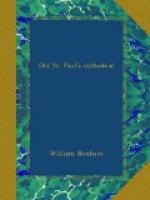Henry III. succeeded, at the age of ten years, to a crown which his father had degraded. The Pope addressed him as “Vassallus Noster,” and sent his legates, one after another, to maintain his authority. It was in St. Paul’s Cathedral that this authority was most conspicuously asserted. Before the high altar these legates took their seat, issued canons of doctrine and discipline, and assessed the tribute which clergy and laity were to pay to the liege lord enthroned at the Vatican. But the indignation of the nation had been waxing hotter and hotter ever since King John’s shameful surrender. Nevertheless, in the first days of the boy King’s reign, the Papal pretensions did good service. The barons, in wrath at John’s falseness, had invited the intervention of France, and the Dauphin was now in power. In St. Paul’s Cathedral, half England swore allegiance to him. The Papal legate, Gualo, by his indignant remonstrance, awoke in them the sense of shame, and the evil was averted. Then another council was held in the same cathedral, and the King ratified the Great Charter.
Henry III. grew to manhood, and gave himself up to the management of foreign favourites, and in 1237, instigated by these, who were led by Peter de la Roche, Bishop of Winchester, he invited Pope Gregory IX. to send a Legate (Cardinal Otho “the White”) to arrange certain matters concerning English benefices, as well as some fresh tribute. They called it “promoting reforms.” Their object was to support him in filling all the rich preferments with the Poitevins and Gascons whom he was bringing over in swarms. The Cardinal took his lofty seat before the altar of S. Paul’s, and the King bowed before him “until his head almost touched his knees.” The Cardinal “lifted up his voice like a trumpet” and preached the first sermon of which we have any report in St. Paul’s. His text was Rev. iv. 6, and he interpreted “the living creatures” as the bishops who surrounded his legatine throne, whose eyes were to be everywhere and on all sides. The chroniclers tell how a terrific storm burst over the cathedral at this moment, to the terror of the whole congregation, including the Legate, and lasted for fifteen days. It did much harm to the building. The bishop, Roger Niger, exerted himself strenuously in repairing this. Edmund Rich, the Archbishop of Canterbury, indignantly protested against the intrusion of foreign authority, and was joined by Walter de Cantelupe, the saintly Bishop of Worcester, but for a long time they were powerless. Besides direct taxation, wealth raised from the appropriation of rich canonries was drained away from church and state into the Papal treasury. The Legate remained for four years in power. The Archbishop, in despair, retired abroad, and died as a simple monk at Pontigny. The Bishop of London, Roger Niger, was so called from his dark complexion, and people whimsically noted his being confronted with the Cardinal Otto Albus. Bishop Roger, before




